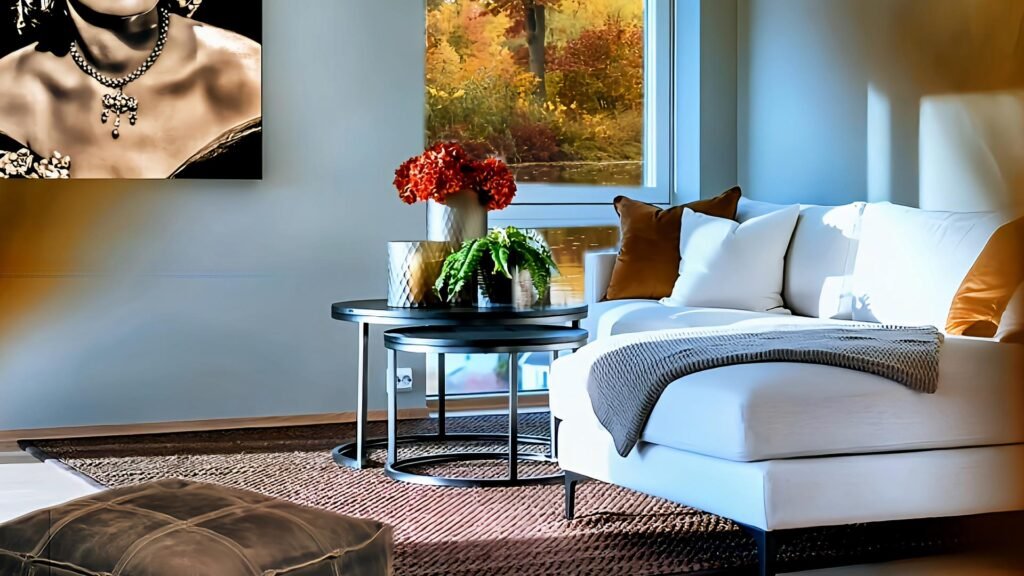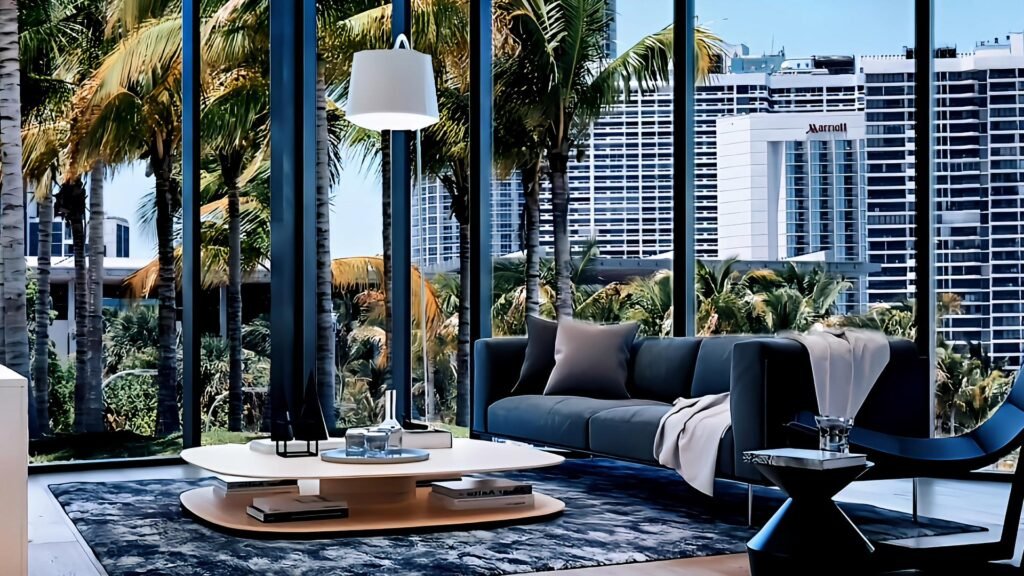Learn how smart furniture placement can transform your small living room into a functional and visually appealing space. Discover strategies for assessing your space, choosing multi-functional furniture, creating zones for different activities, optimizing vertical space, and maintaining a minimalist aesthetic. These tips will help you maximize your room’s potential and create a comfortable, clutter-free environment.

Introduction to Smart Furniture Placement
Smart furniture placement is a critical consideration for small living rooms, where every square foot counts. The challenge of limited space often requires innovative solutions to ensure that the room remains both functional and visually appealing. Strategic planning and thoughtful arrangement of furniture can transform a cramped area into a comfortable and inviting space.
The importance of smart furniture placement cannot be overstated. It involves more than just fitting pieces into a room; it’s about creating a layout that enhances the room’s usability and flow. When done correctly, it can significantly improve the living room’s functionality by making it easier to navigate and reducing clutter. Additionally, it can optimize storage solutions, ensuring that every item has a designated place, which helps in maintaining an organized environment.
One of the primary benefits of smart furniture placement is the illusion of increased space. By thoughtfully arranging furniture, you can make a small living room feel more open and less confined. This is achieved by selecting multi-functional furniture, utilizing vertical space, and ensuring that pathways are clear. Such strategies not only enhance the aesthetic appeal of the room but also contribute to a more comfortable living experience.
Moreover, smart furniture placement can lead to improved flow within the room. This means that movement from one area to another is seamless, and activities such as entertaining guests or relaxing are not hindered by poorly arranged furniture. It also allows for better natural light distribution and ventilation, further enhancing the room’s ambiance.
In summary, smart furniture placement is essential for maximizing the potential of small living rooms. It addresses the challenges posed by limited space through strategic planning and innovative solutions. The result is a more functional, aesthetically pleasing, and spacious-feeling living area that meets the needs of its occupants. By prioritizing smart furniture placement, you can create a small living room that is both practical and stylish.

Assessing Your Space
When dealing with a small living room, the first crucial step is to thoroughly assess the space. Begin by measuring the room’s dimensions, including the length, width, and height. Accurate measurements are essential as they serve as the foundation for any furniture placement decisions. Alongside dimensions, take note of architectural features such as windows, doors, electrical outlets, and any built-in elements. These features can significantly influence furniture placement and accessibility.
Please read our article watch the newly uploaded video from our YouTube channel:
“Grig Stamate – Interior Design Solutions”
https://www.youtube.com/@GrigStamate
Small LIVING ROOMS with Smart FURNITURE PLACEMENT, #2 (video)
Here, you can see other related videos from our channel:
Small LIVING ROOMS with Smart FURNITURE PLACEMENT (video)
Small Living, BIG STYLE [New Modern Living Rooms with Limited Space], #6 (video)
Identifying the room’s focal points is another critical aspect of assessment. Focal points could be a fireplace, a large window, a television, or even a piece of artwork. Recognizing these elements will help in arranging furniture in a way that enhances the room’s visual appeal and functionality. For example, if the focal point is a window with a scenic view, align your seating arrangement to take advantage of this feature.
Creating a floor plan is an effective way to visualize different furniture layouts. You can draw a scaled floor plan on graph paper or use online design software to experiment with various arrangements. Design software offers the added advantage of three-dimensional visualization, allowing you to see how different pieces of furniture will look in your space. This step is invaluable for avoiding common pitfalls such as overcrowding or poor traffic flow.
Understanding the space in detail before purchasing or arranging furniture cannot be overstated. It helps to avoid impulsive buys that may not fit or complement the room. Additionally, a well-thought-out plan ensures that every piece of furniture serves a purpose and contributes to the overall harmony of the living room. By taking the time to assess your space meticulously, you lay the groundwork for a functional and aesthetically pleasing small living room.

Choosing Multi-Functional Furniture
Maximizing space in small living rooms often hinges on the strategic use of multi-functional furniture. These versatile pieces not only save space but also contribute significantly to reducing clutter, creating a more organized and visually appealing environment. Sofa beds, for instance, are a prime example of multi-functional furniture. They offer the comfort of a sofa during the day and can be easily transformed into a bed at night, making them ideal for accommodating guests without the need for a separate guest room.
Another valuable addition to a compact living room is an ottoman with storage. This piece serves as a footrest, additional seating, and a hidden storage unit. By choosing an ottoman with a removable top, you can store blankets, pillows, or other items out of sight, maintaining a tidy space. Similarly, coffee tables that convert into desks are a practical solution for those who need a workspace but lack the room for a dedicated office. These tables can be adjusted to different heights, allowing for a seamless transition from a casual coffee table to a functional desk.
When selecting multi-functional furniture, it is crucial to prioritize quality and versatility. Look for pieces made from durable materials that can withstand frequent use and offer longevity. Additionally, consider furniture that complements your overall design aesthetic. Opt for neutral colors and timeless designs that can easily integrate with various décor styles. High-quality multi-functional furniture not only enhances the functionality of a small living room but also adds a touch of sophistication and elegance.
Incorporating multi-functional furniture into your small living room is a smart strategy for maximizing space. By thoughtfully selecting pieces that serve multiple purposes, you can create a more efficient and clutter-free living area that meets your needs without sacrificing style or comfort.
Creating Zones for Different Activities
In a small living room, effective zoning is paramount to maximizing space and functionality. Zoning involves dividing the room into distinct areas for various activities, such as lounging, working, and entertaining, without overcrowding. This strategic approach not only enhances the room’s usability but also maintains a sense of order and cohesion.
One practical method to achieve zoning is through the use of rugs. Rugs can visually separate different areas, such as a lounging zone and a workspace, by defining boundaries without the need for physical partitions. For instance, placing a large rug under the seating area can demarcate it as a lounging space, while a smaller rug under a desk can signify a dedicated workspace.
Furniture arrangement plays a crucial role in zoning as well. Positioning a sofa or sectional to face away from a workspace can create a clear distinction between the lounging and working areas. Additionally, using multifunctional furniture, such as a sofa bed or a foldable desk, can help maintain flexibility in the room’s layout, allowing you to adapt the space as needed.
Lighting is another essential element in delineating zones. Different lighting fixtures can be used to highlight specific areas and set the mood for various activities. For example, a floor lamp next to the sofa can create a cozy reading nook, while a table lamp on the desk provides focused light for working. Layered lighting, which combines ambient, task, and accent lighting, can further enhance the functionality and ambiance of each zone.
While creating distinct functional areas, it’s important to maintain a cohesive look throughout the living room. This can be achieved by using a consistent color palette and complementary decor elements. For example, matching the colors of the rugs and cushions or using similar materials and finishes for furniture pieces can tie the zones together, ensuring a harmonious and visually appealing space.
By thoughtfully zoning your small living room, you can maximize its potential and create a balanced, versatile environment that caters to all your needs.
Optimizing Vertical Space
In small living rooms, maximizing vertical space is essential for creating an open, airy environment. Utilizing vertical space effectively can free up valuable floor space, making the room feel more spacious and less cluttered. One of the most efficient strategies for optimizing vertical space is installing wall-mounted shelves. These shelves can hold books, decorative items, or even everyday essentials, keeping them off the floor and within easy reach.
Another practical solution is the use of tall bookcases. These bookcases not only provide ample storage but also draw the eye upward, creating the illusion of a taller room. When selecting a bookcase, consider one that fits snugly against the wall to maximize floor space. Additionally, you can use the top portion of the bookcase for decorative elements, such as plants or art pieces, to add a personal touch to your living room.
Hanging decorative elements is another effective way to utilize vertical space. Wall art, mirrors, and even hanging planters can add character to your living room without taking up any floor space. Mirrors, in particular, can enhance the perception of space by reflecting light and making the room feel larger and more open. When arranging wall art or mirrors, consider a cohesive layout that complements the overall design of your living room.
For those looking for stylish and practical vertical storage solutions, consider multifunctional furniture. Furniture pieces like a wall-mounted desk with built-in shelves or a sofa with overhead storage compartments can offer additional storage without compromising on style. These solutions are particularly useful in small living rooms where every inch of space matters.
By focusing on vertical space, homeowners can transform their small living rooms into functional and visually appealing areas. Incorporating these strategies not only maximizes space but also enhances the overall aesthetic, making the living room a more enjoyable place to relax and entertain.
Strategic Furniture Placement Tips
When working with small living rooms, strategic furniture placement is essential to maximize space and functionality. One of the primary goals is to keep pathways clear to ensure easy movement throughout the room. Positioning larger pieces, such as sofas and entertainment units, against the walls can help open up the center of the room, making it feel more spacious. This approach not only conserves floor space but also allows for a more balanced distribution of furniture.
Arranging seating to encourage conversation is another crucial aspect. Placing chairs and sofas facing each other or at right angles can create an inviting and cohesive conversation area. Additionally, using a round coffee table can soften the layout and facilitate easier movement around the seating area. Opt for furniture with sleek lines and minimalistic designs to avoid overwhelming the space.
Balancing the room by distributing furniture evenly can prevent one side from appearing too heavy. For instance, if you have a large sofa on one side, consider balancing it with a pair of smaller chairs or a console table on the opposite side. Choosing appropriately scaled pieces is vital; oversized furniture can make a small room feel cramped, while smaller, multifunctional pieces can enhance the sense of space.
Visual aids, such as floor plans or diagrams, can be incredibly helpful in planning furniture placement. These tools allow you to experiment with different arrangements before committing to a specific layout. In addition to traditional furniture, consider incorporating built-in storage solutions, such as wall-mounted shelves or under-sofa storage, to further optimize space.
In summary, the key to maximizing space in a small living room lies in thoughtful furniture placement and balancing the room’s elements. By keeping pathways clear, encouraging conversation through strategic seating arrangements, and choosing appropriately scaled furniture, you can create a functional and inviting living space.
Incorporating Mirrors and Light
In small living rooms, the strategic use of mirrors and lighting can significantly enhance the perception of space. Mirrors are one of the most effective tools for creating the illusion of a larger room. By reflecting light and views, they can make a compact space feel more open and airy. When positioning mirrors, consider placing them opposite windows or other light sources. This placement maximizes the amount of light reflected into the room, brightening the space and adding depth. Full-length mirrors or mirrored walls can amplify this effect, providing an expansive feel even in the most confined areas.
Lighting plays a crucial role in maximizing the space in a small living room. Layered lighting, which includes ambient, task, and accent lighting, helps to eliminate shadows and highlights key areas, making the room appear larger. Overhead lighting, such as chandeliers or pendant lights, provides general illumination, while wall sconces and floor lamps can offer focused task lighting. Recessed lighting is another excellent option, as it provides ample light without occupying physical space.
Natural light is a valuable asset in small living rooms. To maximize it, use sheer or light-filtering window treatments that allow sunlight to pour into the room while maintaining privacy. Avoid heavy drapes or dark curtains, as they can make the room feel more enclosed. Position furniture away from windows to ensure that natural light is not obstructed. Additionally, choosing light-colored furniture and decor can reflect natural light, enhancing the overall brightness of the space.
Incorporating mirrors and optimizing lighting are fundamental strategies in creating a spacious and inviting atmosphere in small living rooms. By thoughtfully placing mirrors and selecting appropriate lighting fixtures, you can transform a confined area into a visually larger, brighter, and more functional living space.
Maintaining a Minimalist Aesthetic
Embracing a minimalist aesthetic in a small living room can significantly enhance the sense of space and tranquility. A clutter-free environment not only makes the room feel larger but also creates an inviting and serene atmosphere. By focusing on simplicity and functionality, you can maximize the potential of even the most compact living areas.
Choosing an appropriate color palette is pivotal in achieving a minimalist look. Opt for neutral tones such as whites, grays, and beiges, which can make the room appear more spacious and airy. These colors serve as a versatile backdrop, allowing you to introduce subtle accents through cushions, rugs, or artwork without overwhelming the space.
When selecting furniture, prioritize pieces that are both simple and stylish. Multi-functional furniture, such as a sofa bed or an ottoman with storage, can save space while adding practicality. Look for furniture with clean lines and minimal ornamentation, as these designs tend to contribute to a more open and cohesive appearance.
Incorporating minimal decor elements is crucial in maintaining a minimalist aesthetic. Avoid over-decorating walls and surfaces; instead, choose a few key pieces that reflect your personal style. A single statement artwork or a well-placed mirror can add character without cluttering the space. Additionally, functional decor such as sleek lighting fixtures and unadorned shelves can enhance the room’s appeal while maintaining simplicity.
Regular decluttering and organizing are essential to sustain this aesthetic over time. Adopt a habit of routinely assessing your living room for items that are no longer needed or used. Storage solutions, such as built-in shelves or hidden compartments, can aid in keeping the space orderly. By consistently managing clutter, you will preserve the minimalist ambiance and ensure that your small living room remains a comfortable and inviting haven.
Other related posts from our website:
Let’s see here, three of them:
https://howtobuildahouseblog.com/maximizing-space-smart-furniture-placement-for-small-living-rooms/
https://howtobuildahouseblog.com/how-to-style-a-small-living-room-on-a-budget-2/
https://howtobuildahouseblog.com/the-50-most-popular-small-living-rooms-so-far-in-2024/
We also sincerely hope you like our ideas from this post, and you have also enjoyed our uploaded YouTube video.
See you next time at another article.
Thank you so much for your time. Bye now!



No Responses